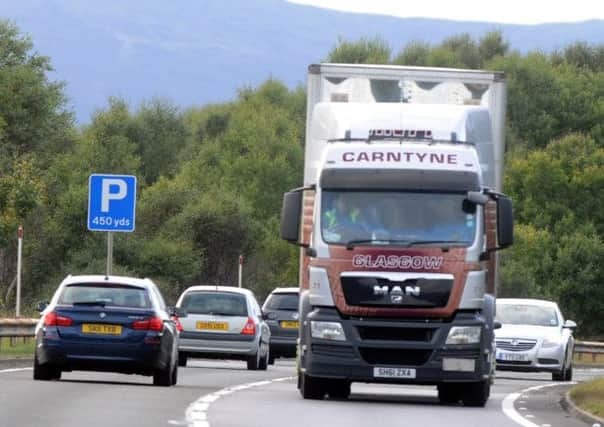Raise lorry speed limit in Scotland to 50mph call


The limit for lorries on single carriageway roads in England and Wales will be raised from 40mph to 50mph next year.
However, in Scotland the new limit will only operate on the A9 between Perth and Inverness from October, as a trial to coincide with the introduction of average speed cameras.
Advertisement
Hide AdAdvertisement
Hide AdA further difference could follow since the UK Government is seeking views on raising the lorry limit on dual carriageways from 50mph to 60mph south of the Border.
The changes would mean lorry drivers having to alter their speed as they crossed the Border, such as on the A1 near Berwick-upon Tweed, and the A68 and A7 in the Borders.
The UK Government said the higher limit, expected to be introduced in April, would save hauliers £11 million a year.
Cycling groups fear it will hit road safety, and the Scottish Government, taking a more cautious approach in only approving a one-road trial, has pointed to research that casualty figures are likely to increase.
The first cross-Border variation of speed limits follows the Scotland Act 2012 devolving the power from Westminster.
The Institute of Advanced Motorists said the higher limit should be introduced across Scotland if the A9 trial was successful.
Neil Greig, its Scotland-based policy and research director, said: “The IAM are worried that different lorry speed limits north and south of the Border will confuse professional and private drivers alike.
“Lorry drivers won’t be sure what speed to drive at, leading to potential speeding convictions and loss of earnings, and the ordinary motorist will not be sure how fast the heavy goods vehicle (HGV) in front of them can actually travel when they start an overtake.
Advertisement
Hide AdAdvertisement
Hide Ad“The A9 pilot study offers a great opportunity to see if 50mph for large vehicles is safe.
“Ideally, the first six months will be conclusive enough for the Scottish Government to be able to decide to align with the rest of the UK in April 2015.”
Mr Greig said there should also be a consultation on 60mph limits on dual carriageways “so the Scottish economy is not put at any disadvantage”.
The Automobile Association agreed there should be parity on both sides of the Border.
Spokesman Paul Watters said: “Scotland has an extensive network of A roads linking key towns and cities, and allowing lorries to travel at 50mph and not 40mph on single carriageway roads would have the same benefits as suggested for England.
“These are economic benefits, for example getting goods moved swifter and cutting journey times for all traffic, which sometimes gets held up behind a lorry moving at 40mph over long distances.
“Higher lorry speed reduces the dangers of risky overtaking caused by driver frustration.
“Consistency with HGV speed limits on UK roads would be helpful to both business and road users generally.”
Advertisement
Hide AdAdvertisement
Hide AdBoth the Freight Transport Association and Road Haulage Association backed the higher limit across Scotland.
But British Cycling campaigns manager Martin Key said: “It’s staggering the [UK] Government has increased the speed limit for these vehicles when many of them are simply not fit for purpose.
“HGVs are involved in a fifth of cyclist fatalities and many of the vehicles have large blind spots which prevent drivers seeing people near the cab.”
A spokesman for the Scottish Government’s Transport Scotland agency said: “We will work with the [UK] Department for Transport (DfT) over the next few months to make sure details of speed limits in Scotland, including those on the A9, are featured in their communications around the changes in England and Wales.
“This will be in addition to our own campaign around the changes on the A9.
“Many drivers already travel across Europe, where there is variation in speed limits from country to country, so an understanding of different limits is already common practice.
“There are no plans to replicate the increases in Scotland as we do not believe there is robust evidence currently available to justify a widespread change in thespeed limit.
“The decision to increase the limit on the A9 was made on the basis that it was done in conjunction with the average speed camera system.
“We have asked the DfT how the measures will be reviewed and how any success will be measured, in order to gain better clarity on how decisions are being reached and what this means for Scotland.”